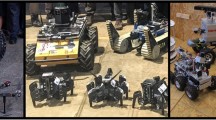Abstract
This paper introduces the Focused Stochastic Diffusion Network as a novel method of self-localisation for an autonomous wheelchair in a complex, busy environment. The space of possible positions is explored in parallel by a set of cells searching in a competitive co-operative manner for the most likely position of the wheelchair in its environment. Experimental results from the SENARIO autonomous wheelchair project indicate the technique is practical and robust.
Similar content being viewed by others
References
Beattie, P. D.: SENARIO: Sensor Aided intelligent wheelchair navigation, in: IEE Power Division, Colloquium on New Developments in Electric Vehicles for Disabled Persons, 1995/055, pp. 2/1–2/4.
Bilgiç, T. and Türksen, L. B.: Model-based localization for an autonomous Mobile Robot Equipped with Sonar Sensors, in: IEEE Int. Conf. on Systems Man and Cybernetics, Intelligent Systems for the 21st Century, Vol. 4, 1995, pp. 3718–3723.
Bishop, J. M.: Stochastic searching network, in: Proc. 1st IEE Conf. on Artificial Neural Networks, 1989, pp. 329–331.
Bishop, J. M., Keating, D. A., and Mitchell, R. J.: A compound eye for a simple robotic insect, in: Proc. Weightless Neural Network Workshop, 1995, pp. 41–47.
Bishop, J. M. and Torr, P.: The stochastic search network, in: R. Linngard, D. J. Meyers, and C. Nightingale (eds.), Neural Networks for Images, Speech and Natural Languages, Chapman and Hall, New York, 1992.
Bourhis, G., Horn, O., and Agostini, Y.: Location and high level planning for a powered wheelchair, in: IEEE Int. Conf. on Systems, Man and Cybernetics, 1994, pp. 2629–2634.
Byler, E., Chun, W., Hoff, W., and Layne, D.: Autonomous hazardous waste drum inspection vehicle, IEEE Robotics and Automation Magazine 2(1) (1995), 6–17.
Cox, I. J.: Blanche - An experiment in guidance and navigation of an autonomous robot vehicle, IEEE Trans. Robotics Automat. 7(2) (1991), 193–204.
Drumheller, M.: Mobile robot localization using sonar, IEEE Trans. Pattern Anal. Mach. Intell. PAMI-9(2) (1987), 325–332.
Durieu, C., Clergeot, H., and Monteil, F.: Localization of a mobile robot with beacons taking erroneous data into account, in: IEEE Proc. of Conf. on Robotics and Automation, Vol. 2, 1989, pp. 1062–1068.
Evans, J., Krishnamurthy, B., Barrows, B., Skewis, T., and Lumelsky, V.: Handling real-world motion planning: A hospital transport robot, IEEE Control Systems (1992), 15–19.
Figueroa, F. and Mahajan, A.: A robust navigation system for autonomous vehicles using ultrasonics, Control Engineering Practice 2(1) (1994), 49–59.
Freund, E. and Dierks, F.: Laser scanner based free navigation of autonomous vehicles, in: 1st IFAC Internat. Workshop on Intelligent Autonomous Vehicles, 1993, pp. 227–232.
Galles, D.: Map building and following using teleo reactive trees, in: Intelligent Autonomous Systems, IAS-3, Proc. of the Internat. Conf., 1993, pp. 390–398.
Katevas, N., Sgouros, N. M., Tzafestas, S., Papakonstantinou, G., Beattie, P., Bishop, J. M., Tsanakas, P., and Koutsouris D.: The autonomous mobile robotics technology for the locomotion handicap: Operation and technical issues, in: Proc. 2nd TIDE Congress, Paris, 1995, pp. 371–374.
Lippmann, L. P.: An introduction to computing with neural nets, IEEE ASSP Magazine (1987), 4–22.
Madarasz, R. L., Heiny, L. C., Robert, R. F., and Mazur, N. M.: The design of an autonomous vehicle for the disabled, IEEE J. Robotics Automat. RA-2(3) (1986), 117–125.
Marshall, G. F. and Tarassenko, L.: Robot path planning using VLSI resistive grids, IEE Proc. of Vision and Image Signal Processing 141(4) (1994), 267–272.
Nasuto, S. J. and Bishop, J. M.: Convergence analysis of stochastic diffusion search, Technical Report-SDS1, Dept. Cybernetics, University of Reading, 1997.
Tarassenko, L., Brownlow, M., Marshall, G., and Tombs, J.: Real-time autonomous robot navigation using VLSI neural networks, in: Lippman, Moodey and Touretzky (eds.), Adv. in Neural Inform. Processing Systems, 3, Morgan Kaufmann, 1991, pp. 422–428.
Townsend, N. W., Brownlow, M. J., and Tarassenko, L.: Radial Basis Function Networks for Mobile Robot Localisation, 1991.
Wilkes, D.: Using point range samples for reprojection of model views for landmark-based robot navigation, SPIE, Vol. 2355, Sensor Fusion VII, 1994, pp. 147–156.
Author information
Authors and Affiliations
Rights and permissions
About this article
Cite this article
Beattie, P.D., Bishop, J.M. Self-Localisation in the ‘Senario’ Autonomous Wheelchair. Journal of Intelligent and Robotic Systems 22, 255–267 (1998). https://doi.org/10.1023/A:1008033229660
Issue Date:
DOI: https://doi.org/10.1023/A:1008033229660




